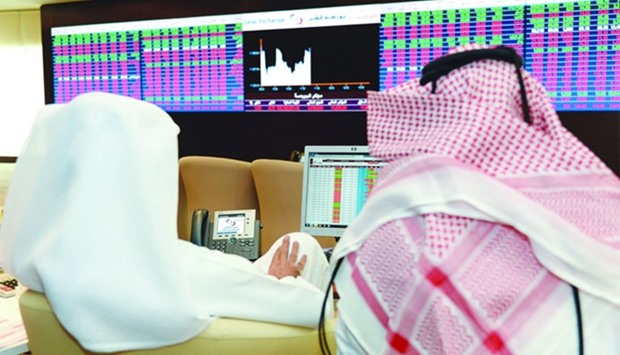Foreign institutions’ weakened buying support was visible on the QSE during the week, which saw Qatar Electricity and Water Company report net profit of QR1.23bn in the first nine months of this year.
The QSE’s main barometer 20-stock Qatar Index lost 0.64% during the week which saw QIIB post QR666.4mn net profit during January-September 2016.
Elsewhere in the Gulf region, Muscat recorded 1.17% decline, Dubai (0.66%), Bahrain (0.32%) and Abu Dhabi (0.05%); whereas Saudi Arabia gained 5.03% and Kuwait (1.44%) during the week which saw Mesaieed Petrochemical Holding Company declare a net profit of QR716mn in the first nine months of this year.
The Qatari bourse’s year-to-date losses were at 0.56% compared to 14.11% in Saudi Arabia, 5.57% in Bahrain, 3.87% in Kuwait and 0.34% in Abu Dhabi; even as Dubai and Muscat gained 15.31% and 1.68% respectively.
“The results by and far reflected the general sentiments and it is not something uncommon to this part of the world; given the weak outlook on hydrocarbons despite the recent supply side measures announced by the Organisation of the Petroleum Exporting Countries; which is yet to crystallise,” an analyst with a brokerage firm said.
Realty, consumer goods and transport witnessed higher than average selling pressure during the week which saw Gulf International Services report a net profit of QR189mn during January-September 2016.
Trade turnover and volumes were on the rise during the week which witnessed Qatar First Bank registering a net profit of QR3.4mn during the third quarter of 2016.
Islamic stocks were seen declining slower than the conventional ones during the week which saw Aamal Company post a net profit of QR423.7mn in January-September this year.
Non-Qatari individual investors were increasingly into net selling during the week which saw the Institute of International Finance view that Qatar's fiscal breakeven oil price of $60 a barrel this year is more than 13% lower than the Gulf Cooperation Council (GCC) average but higher than that of Kuwait and the UAE.
However, net profit booking pressure eased in the case of local retail investors and domestic institutions during the week QIIB announces its plan to open new branches at the City Center Mall and the Mall of Qatar to strengthen the domestic network and also hopes to soon open a new joint venture bank in Morocco.
Opening the week weak at 10,434 points, the market kept gaining for the subsequent three days to reach a low of 10,363 points; after which there was some buying interests on the last day; but overall the index had lost 67 points during the week which saw industrials, banking and telecom together constituted about 82% of the total volumes.
Tracking the main barometer, the 20-stock Total Return Index also shrank 0.64%, All Share Index (comprising wider constituents) by 0.69% and Al Rayan Islamic Index by 0.52% during the week which witnessed Qatar’s trade surplus expand about 2% to QR8.85bn in September against that in previous month as imports fell mush faster than exports.
Real estate sector saw its stock prices shrink 2.92%, consumer goods (2.42%), transport (1.31%), telecom (0.2%), industrials (0.03%) and insurance (0.02%); while banks and financial services gained 0.13% during the week which saw Qatar’s producer price index gain about 3% in August.
Market capitalisation fell 0.71% or about QR4bn to QR558.57bn during the week.
Of the 44 stocks, as many as 27 fell, while 15 rose and two were unchanged. Seven each of the 13 banks and financial services and the nine consumer goods; five of the eight industrials; three of the four real estate; two each of the five insurers and the three transport; and one of the two telecom scrips settled lower during the week.
Among the major losers were Industries Qatar, Aamal Company, Ezdan, Mazaya Qatar, Gulf Warehousing, Nakilat, Gulf International Services, Qatar First Bank, Doha Bank, Alijarah Holding, Islamic Holding Group and Medicare Group; whereas Qatari Investors Group, Commercial Bank, Qatar Industrial Manufacturing, Vodafone Qatar and United Development Company were among the gainers during the week.
Foreign institutions’ net buying weakened considerably to QR155.23mn compared to QR283.71mn the previous week.
Non-Qatari individual investors turned net profit booking increased to QR7.38mn against QR3.16mn the week ended October 20.
However, domestic institutions’ net selling weakened perceptibly to QR104.26mn compared to QR191.45mn the previous week.
Local retail investors’ net profit booking also declined to QR43.69mn against QR89.01mn the week ended October 20.
Total trade volume rose 28% to 29.17mn shares and value by 8% to QR970.79mn; while transactions were down 5% to 12,144 during the week.
The industrials sector’s trade volume more than doubled to 8.41mn equities and value also more than doubled to QR393.2mn on 28% jump in deals to 2,900.
There was 53% surge in the telecom sector’s trade volume to 7.23mn stocks, 18% in value to QR90.63mn and 11% in transactions to 1,358.
The banks and financial services sector’s trade volume expanded 10% to 8.23mn shares, while value fell 6% to QR316.33mn and deals by 13% to 3,932.
However, the market witnessed 59% plunge in the consumer goods sector’s trade volume to 0.62mn equities, 62% in value to QR49.42mn and 10% in transactions to 1,246.
The transport sector’s trade volume plummeted 44% to 0.9mn stocks, value by 59% to QR35.09mn and deals by 56% to 651.
The real estate sector reported 8% shrinkage in trade volume to 3.58mn shares and value by 11% to QR7.72mn; but on 12% growth in transactions to 1,740.
The insurance sector’s trade volume was down 5% to 0.2mn equities, value by 2% to QR14.41mn and deals by 15% to 317.
In the debt market, there was no trading of treasury bills and government bonds during the week.



